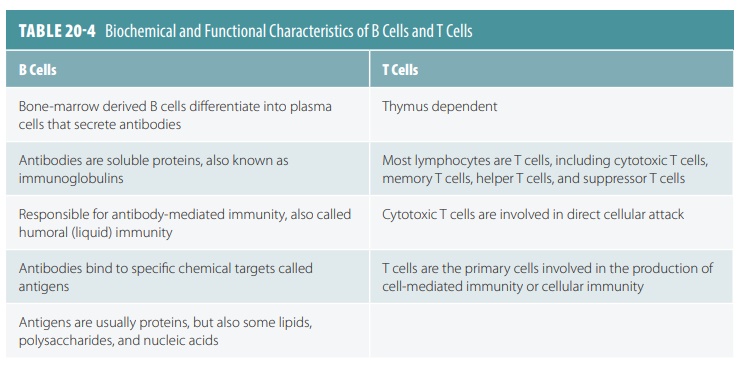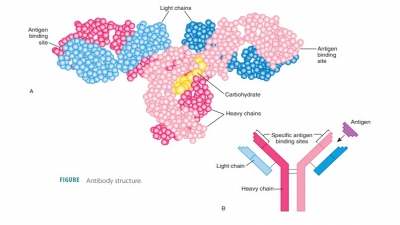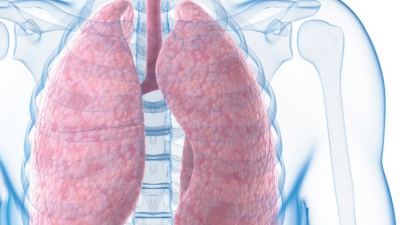Cellular Immune Response
| Home | | Anatomy and Physiology | | Anatomy and Physiology Health Education (APHE) |Chapter: Anatomy and Physiology for Health Professionals: Lymphatic System and Immunity
T cells attach to foreign, antigen-bearing cells such as bacterial cells and interact with direct cell-to-cell con-tact. This is known as cellular immune response or cell-mediated immunity.
Cellular
Immune Response
T cells attach to foreign, antigen-bearing cells such as
bacterial cells and interact with direct cell-to-cell con-tact. This is known
as cellular immune response or
cell-mediated immunity. T cells, along with some mac-rophages, also synthesize
polypeptides called cytokines that
enhance responses to antigens. Interleukin-1 and interleukin-2 stimulate synthesis of cytokines fromother T cells.
Other cytokines, called colony-stimulatingfactors,
stimulate leukocyte production in red bonemarrow, activate macrophages, and
cause B cells to grow. In the cellular immune response, lympho-cytes themselves
defend the body. The targets of cell- mediated immunity are cancer cells,
cells of foreign grafts, and tissue cells infected with viruses or parasites.
Lymphocytes either directly kill infected cells or cause their death indirectly
by releasing their chemicals that enhance inflammation or activate other
lymphocytes or macrophages. Both B and T lymphocytes acquire immunocompetence
and self-tolerance in different
locations in the body.
Certain activated T cells kill body cells that are infected
by bacteria or viruses directly. They also may directly kill cells that are
cancerous or abnormal and cells from foreign tissues that have been
transplanted or infused. Different T cells release chemicals that reg-ulate the
immune response. T cells that mediate cellu-lar immunity are much more
complicated in function and classification that B cells. The two primary types
of T cells are identified by cell
differentiation glycopro-teins known as CD4 or CD8. Both are surface
recep-tors that are different from T cell antigen receptors and help with
interactions between other cells and T cells. Activation of CD4 and CD8 cells
differentiate them into three major types of effector cells involved in cellular immunity. CD4 cells usually
become helperT cells, and activate B
cells, other T cells, and macro-phages. They direct the adaptive immune
response. CD8 cells become cytotoxic T
cells, destroying cells in the body that contain anything foreign. Some CD4
cells become regulatory T cells,
which regulate the immune response. Activated CD4 and CD8 cells can also become
memory T cells. All T cells have a CD3 receptor complex in the plasma
membranes thateventually activates them to recognize antigens.
Antigen-Presenting Cells
Before it can respond to an antigen, a lymphocyte must be
activated. T cells are activated by the presence of processed antigen fragments
attached to the surface of an antigen-presenting
cell, also called an accessorycell,
which may be macrophages, B cells, or other typesof cells. Antigen-presenting
cells have important aux-iliary functions in regard to antigens and respond to
them differently than lymphocytes do. When a mac-rophage phagocytizes a
bacterium and digests it in its lysosomes, T-cell activation begins. Some
bacterial antigens then move to the surface of the macrophage. They are
displayed near certain protein molecules that make up the major histocompatibility complex (MHC).
MHC antigens help T cells recognize foreign antigens. Helper T cells contact
displayed foreign anti-gens. If the antigen combines with the helper T cell’s
antigen receptors, it becomes activated and stimulates a B cell to produce
antibodies specific for the displayed antigen. The membrane glycoproteins
formed as part of the MHC are known as MHC
proteins or humanleukocyte antigens.
Class I MHC
proteins are found in the plasmamembrane of every nucleated cell.
Their activation eventually results in destruction of abnormal cells, which is
a significant component why donated organs are often rejected. Class II MHC proteins are only found in
plasma membranes of antigen-presenting cells and lymphocytes. Phagocytic
antigen-presenting cells break down and engulf foreign antigens or pathogens
This antigen processing creates
antigen fragments, which become bound to class II MHC proteins and then inserted
into the plasma membrane. The class II MHC proteins only appear in the plasma
mem-brane when the cell is processing antigens. TABLE 20-4 summarizes biochemical and functional characteris-tics of B
cells and T cells.

Related Topics


